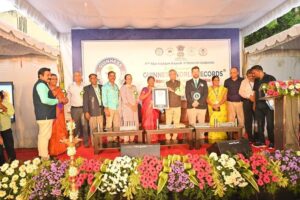
Dr Gunvantrai Ganpatlal Parikh
Dr Gunvantrai Ganpatlal Parikh or GG to his friends is one of the ’42 Augusters’. This new phrase, ’42 Augusters’, came to be a part of modern history due to freedom fighters who participated in August Kranti also known as the Quit India Movement of 1942 and were imprisoned by the British.
GG had covered his face with a handkerchief on that rainy day in the Gowalia Tank Maidan aka August Kranti Maidan, in Bombay. It was the first time that police used tear gas when Aruna Asaf Ali hoisted the tricolour in the Gowalia Tank Maidan on August 9, 1942.
Last year, the Mumbai Press Club invited Dr Parikh to the Red Ink awards ceremony, where he shared his experiences from days of freedom struggle. He called himself the product of the circumstances.
The doctor, who will celebrate his 100th birthday on December 30 this year, has a fine memory and his commitment to social causes has remained unwavering throughout the last many decades. He recollected that the leadership of the independent India had betrayed the Mahatma. He said, “We were told that after independence, the rulers would be the servants of the public. But they started imitating the British, and that was the first betrayal. It’s not that we turned anti-Nehru, but we felt bad that Gandhi was forgotten so soon.”
Also read: August Kranti: The most serious rebellion since the 1857 uprising
Dr Parikh was born on the bank of the Bhogavo River, one of the tributaries of the Sabarmati in Wadhwan, about 3 kilometres from the district headquarters of Surendranagar in Gujarat. He graduated in medical science from the G.S. Medical College, Parel (Mumbai) in 1950 and started practising to continue the tradition of Dr. Bidhan Chandra Roy. He considers attending to patients as a duty or a ritual of the clinic. Almost 75 years of practice is enough to make him one of the oldest practitioners of medical science in the 21st century.
Before earning the doctor’s degree, he was the founding member of the All India Students Congress (AISC) known today as NSUI (National Students Union of India). He was fully active in it between 1943 and 1947. During the Quit India Movement, since most of the Congress Party leaders were in jail, and the Bombay Pradesh Congress Committee (BPCC) was is a state of coma, the AISC acted like a mature political party, and Parikh offered services in its activities including collection of funds and to support the Royal Indian Navy mutiny. He was the president of the Bombay unit of the Student’s Congress in 1947 and also contributed to the trade union movement and promotion of consumer cooperatives.
GG, as Parikh is fondly called, recollected how he ran away to the Prarthana Samaj before moving into the safe zone of his hostel on August 9, 1942. He was arrested at Churchgate Station during another incident of picketing with a group of student volunteers and was sent to the Worli Temporary Prison (WTP). Time came a full circle when he was arrested again, this time in Independent India, during the Emergency on October 23, 1975, together with socialist leader George Fernandes. As such he is one of those rare individuals to be at the receiving end of the two extreme acts of authoritarianism in Indian history. Last year GG was making news during the annual ritual of the Quit India march to Chaupati beach and August Kranti Maidan.
Dr. Parikh had joined the Congress Socialist Party along with some other members of the 42 Augusters club. He never tried to gain political power and remained all focused on the values and creative works that Mahatma Gandhi had tried hard to promote. He believed that real social reform cannot be achieved through political power, it can only come through the moral authority, the kind that Mahatma Gandhi, Nelson Mandela and Martin Luther King possessed. Here he refers to the moral authority that arises out of the action on the ground. His own long life is an embodiment of the Gandhian lifestyle.
Yusuf Meharally, his top source of inspiration, coined the two most powerful slogans of the previous century – “Simon! Go Back”, and “Quit India”. He used to be the most popular leader among students including GG in Mumbai. GG is one of the founders of Yusuf Meharalli Centre which was started informally in 1961 and confirmed later with formal inauguration by Dr. Zakir Husain, the Vice-President of India in 1966.
GG represents the spirit of certain socialist leaders like Yusuf Meharalli, Acharya Narendra Dev, Ram Manohar Lohia, Jayaprakash Narayan, Ram Nandan Mishra, Usha Mehta, etc. His thoughts and works about the questions of social harmony can remind the sacrifices of Ganesh Shankar Vidyarthi.
*Author of The Holy Ganga (Rupa 2008) and Honourary Secretary, Srishti Sustainable Development Foundation.






